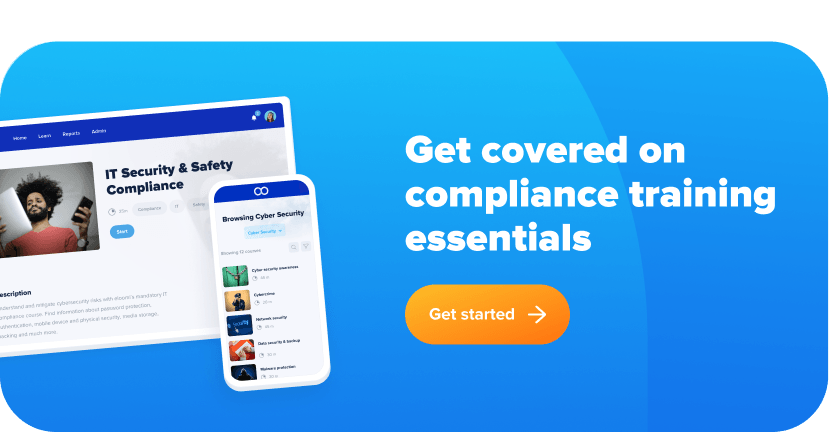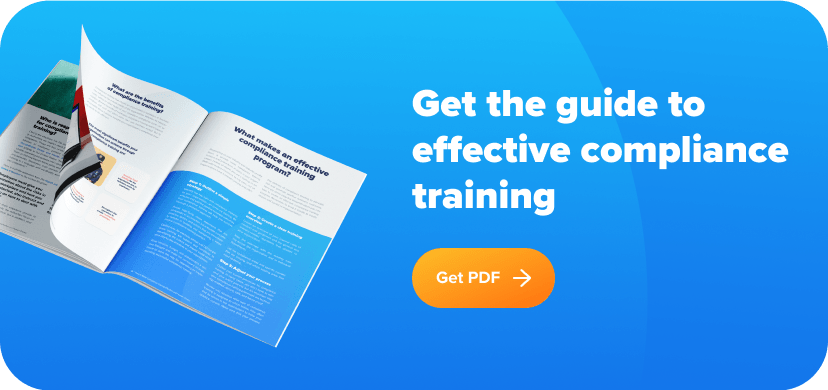What it is: California compliance and employment laws are some of the most progressive in the country, providing more rights for employees, and more responsibilities for employers.
Why it matters: Without proper training, your company could violate key California employment laws, facing harsh penalties and lawsuits. Get in touch today to ensure quality compliance training and coverage.
California compliance topics can get dense and confusing. We’ll keep it brief and tell you exactly what you need to know. For more information, check out our training on each of these topics, which dive deep into the details of each law, and how your company stays compliant.
California Local Minimum Wage
The current California minimum wage is $15.00 per hour for employers with 26 or more employees, and $14.00 per hour for employers with fewer than 26 employees. This is significantly higher than the federal minimum wage of $7.25 per hour.
By 2023, the minimum wage for all companies operating in California will be $15.00 per hour, and will be updated each year based on inflation. This includes employees who earn tips. You must pay them at least the existing minimum wage, including any tips they receive.
Besides the state minimum wage, local jurisdictions also have their own minimum wages. The University of California Berkeley keeps an updated list of minimum wage by jurisdiction.
Penalites for violation
Employers who violate the California compliance minimum wage laws are subject to a civil penalty of up to $5000 for each violation. In addition, they may be required to pay restitution to the affected workers and could be subject to criminal prosecution in some cases. Finally, employers who willfully violate the law may be subject to a civil penalty of up to $10,000 for each violation.

California Equal Pay Act & Salary History
California’s Equal Pay Act strengthens existing equal pay protections and prohibits employers from paying employees of different genders unequal wages for “substantially similar work.” The law’s primary purpose is to close the wage gap between women and men by prohibiting employers from paying employees of different sexes differently for “substantially similar work.”
Courts have interpreted “substantially similar work” to mean work that requires comparable skills, effort, and responsibility, and that is performed under similar working conditions. The skills required for the job need not be identical, but they must be sufficiently comparable.
Factors courts will consider in making this determination include:
- The similarities of the job duties
- Whether the jobs have comparable skill requirements
- Whether the mental or physical effort required is comparable
- If the jobs are performed under similar working conditions
- Whether the jobs have comparable supervisory responsibility requirements
However, there are a few exceptions to the rule. For instance, unequal pay is permitted if it can be attributed to a seniority system, a merit system, or a system that measures earnings by quantity or quality of production. Employers may pay different wages if the wage disparity is based on bona fide factors other than gender, such as education, training, or experience.
This same law also prohibits employers from asking candidates about their prior salary history. Employers are also barred from seeking salary history information, including total compensation and benefits, from an applicant. If an applicant asks for the pay scale or range for a position, an employer must provide it to them.
Compliance Note: California compliance law does not yet require employers to post the pay scale or salary range in a public job description like some other states do. Be aware, however, that this change is most likely coming soon.
Ban the Box
California’s Fair Chance Act is a law that prohibits employers from inquiring about an applicant’s criminal history on an initial job application. The law bans the box, a term used to describe a checkbox on job applications asking candidate’s whether they have a criminal conviction.
This means that businesses can no longer ask about an applicant’s criminal history on a job application or during an initial interview. The law applies to all employers in California, regardless of size. Employers who violate the law can be fined for each offense.
The Fair Chance Act is intended to give applicants with criminal records a fair shot at getting hired. If you’re an employer in California, you’ll need to make sure that your job applications and interview processes are in compliance with the Fair Chance Act. review your applications and any other hiring materials to ensure that there is no mention of criminal history.
California Family Rights Act
The California Family Rights Act (CFRA) entitles eligible employees to take up to 12 weeks of unpaid, job-protected leave for certain family and medical reasons. The leave can be taken all at once, or intermittently as needed.
To be eligible for leave under the CFRA, an employee must have worked for their employer for at least 12 months, and for at least 1,250 hours during that 12-month period. Employers with 50 or more employees must comply with the CFRA.
An employee may take CFRA leave for any of the following reasons:
- To bond with a new child (including via adoption or foster care placement)
- To care for a sick family member
- To recover from their own serious health condition
Note that an employee does not need to have a qualifying family relationship with the person they are caring for in order to take CFRA leave. For example, an employee may take CFRA leave to care for a domestic partner who is suffering from a serious health condition.
Once an employee has requested CFRA leave, employers must engage in an interactive process with the employee to determine if there is a reasonable accommodation that would allow the employee to take their leave without unduly disrupting business operations. If such an accommodation is not possible, employers must then determine whether there is another position within the company that would better suit the employee’s needs. For example, if an employee requests intermittent leave in order to care for a parent who is undergoing cancer treatment, an employer may consider whether there is another position within the company that would allow the employee to work from home one or more days per week.
The CFRA interacts with the federal Family and Medical Leave Act (FMLA). If an employee takes leave under the FMLA, that time does not count towards the employee’s 12 weeks of protected leave under the CFRA. However, an employer may require an employee to use paid vacation days, paid sick days, or other paid time off before taking unpaid CFRA leave.
California Paid Family Leave
California Paid Family Law is a program that provides partial wage replacement to workers who take time off from work to care for a new child or a sick family member. Employee payroll deductions fund the program.
In California, eligible employees can receive up to six weeks of paid family leave per year. The amount of benefits that an employee receives is based on their wages and how much time they have worked for their employer.
To be eligible for paid family leave benefits in California, an employee must have worked for their employer for at least 12 months and have at least 1,250 hours of service during that 12-month period. The employee is entitled to receive 60 to 70 percent of their weekly wages based on the previous five to 18 months of pay.

California Healthy Workplace Healthy Family Act
California’s Healthy Workplace Healthy Family Act requires all California businesses with over 25 employees to provide paid sick days to their workers. Employees can begin accruing sick days on their first day of work, and they can carry over up to six unused sick days from one year to the next. Full-time employees are entitled to 72 hours (9 days) of paid sick leave per year. Part-time employees are entitled to 24 hours (3 days) of paid sick leave per year.
The purpose of the Healthy Workplace, Healthy Family Act is to allow employees to take time off from work when they or their family members are ill. Employees can use their sick leave for the following reasons:
- To diagnose, care for, or treat an existing health condition
- To prevent the spread of a communicable disease
- To obtain medical attention, diagnosis, care, or treatment after being a victim of domestic violence, sexual assault, or stalking
- To bond with a child after the child’s birth or after placement for adoption or foster care
Bonding leave can be taken in increments as small as one hour. However, employees must take bonding leave within one year of the child’s birth or placement for adoption or foster care.
Employees can also use their paid sick days if they are victims of domestic violence or sexual assault. In these cases, employees can use their paid sick days to seek medical attention, psychological counseling, safety planning, or other assistance related to the domestic violence or sexual assault.
There are a few exceptions to the rule. Employees who are covered by a collective bargaining agreement or who already receive paid time off (PTO) are not entitled to additional paid sick days under the new law. Additionally, seasonal and temporary workers are only entitled to be paid for the hours they have actually worked, not for any unused sick days they may have accrued.
Cal/OSHA Compliance
California has its own Occupational and Safety Health Act, referred to as Cal/OSHA. This law sets in place standards employers must meet to help keep employees safe on the job.
Some of the specific areas that Cal/OSHA covers include general industry, construction, shipyards, longshoring, and agriculture. Within these industries, there are specific standards that must be met in order to ensure employee safety. Some of these standards include requirements for personal protective equipment, first aid kits, and fire extinguishers. Other standards cover topics such as hazard communication, electrical safety, and respiratory protection.
In addition to adhering to the specific standards set forth by Cal/OSHA, businesses must also ensure that they have an effective safety program in place. This program should include measures to identify and correct potential hazards in the workplace.
This California compliance act requires employees to be trained on how to safely perform their job tasks and how to properly use any personal protective equipment that is required. Regular safety audits should be conducted to identify any potential hazards that may have been overlooked. By taking these steps, you can create a safer workplace for your employees and help prevent potential accidents and injuries.
How to get the Best California Compliance Training
It’s important to stay compliant with California employment laws, and that means making sure your HR teams are properly trained on the ever-changing regulations. You don’t want to be caught off guard and end up facing a lawsuit.
To help you, partner with a training platform does the hard work for you, so you can focus on your core business needs. With eloomi, we offer you the best possible compliance training with curated content bundles ready to go inside our award-winning digital training solution.
Get in touch today to make sure your compliance training is up to date with accurate information to help guide and support your employees in their work, or to explore eloomi’s compliance solution..







